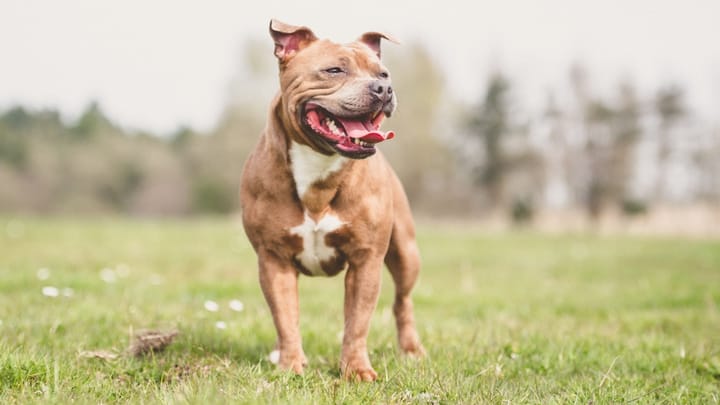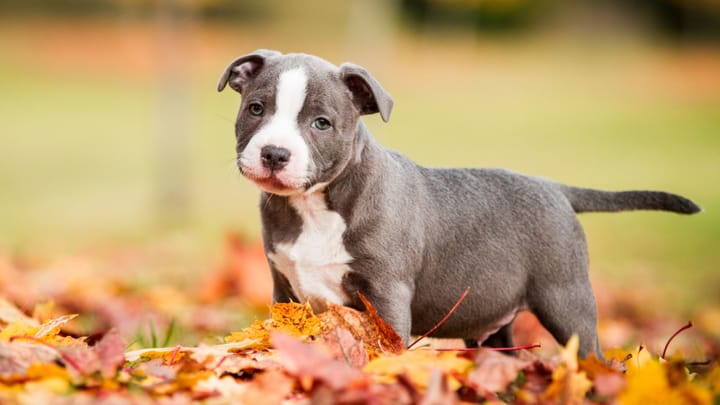Staffordshire Bull Terrier
Other names : Nanny dog, Staffie, Bull terrier du Staffordshire


The Staffordshire Bull Terrier is a compact, muscular, medium-sized dog. Used as a fighting dog in the past, he has preserved a fearless temperament that endows him with remarkable courage. Often mistaken for his close cousin, the Amstaff, the Kennel Club Staffie possesses several traits that make the breed unique in its own right and is not subject to the 1999 law addressing so-called ‘dangerous’ dogs.
|
Life expectancy |
The Staffordshire Bull Terrier has a life expectancy of between 12 and 14 years |
|
Temperament |
|
|
Size |
Medium
|
|
Adult size |
Female
Between 14 and 16 in
Male
Between 14 and 16 in
|
|
Adult weight |
Female
Between 24 and 33 lb
Male
Between 26 and 37 lb
|
|
Coat colour
The Staffordshire Bull Terrier can have a red, fawn, white, black or blue coat. All coats can contain white patching. The coat can also be brindle (in any shade), with or without white. Black and tan or brown coats are not admissible by official standards. Do note that the blue Staffie is particularly sought after. |
Black White Red |
|
Type of coat
The coat is short. The coat is smooth and close-lying. |
Short |
|
Eye colour
The eyes should preferably be a dark colour. |
Brown
|
|
Purchase price |
The Staffordshire Bull Terrier costs between £470 and £965 |
With regards to classifications, only the Staffordshire Bull Terriers lacking Kennel Club papers are assigned the Category 1 group, established by the January 1999 law that addresses so-called ‘dangerous’ dog. It is therefore of utmost importance to only resort to professional breeds when considering the adoption of a Staffordshire Bull Terriers, which will be the only ones capable of ensuring a ‘pure blood’ certificate that will render the dog exempt for the above-mentioned, unjust category.
More details about the Staffordshire Bull Terrier
Staffordshire Bull Terrier: Origins and history
The Staffordshire Bull Terrier was born in the 19th century from a cross between the Bulldog and several different Terriers (White Terrier, Manchester Terrier). Developed in Staffordshire, England, the Staffie was originally used in bull fights. Very widespread in the States since the inter-war period, he has since gained some appreciation throughout Europe. The breed was officially recognised in 1935.
Physical characteristics of the Staffordshire Bull Terrier
He appears as proportionately built, giving the impression of immense strength given his size. The Staffordshire Bull Terrier is muscular, molossian-type dog- active, nimble, brave and tenacious. The head is short, deep, with a wide skull. The masseters are very pronounced; the stop is well-defined. The muzzle is short, and the nose should alway be black. The eyes are round and medium-sized, they are set in a straight manner, casting the gaze directly ahead. The ears can be semi-upright or rose-shaped: they should neither be large nor heavy. The frame is compact, with the upper part following a straight line, a deep and low-reaching chest, and barrel-shaped ribs. The limbs are perfectly straight; the hind feet are slightly crooked. The tail, of medium size, is carried low: large at its base, it tapers down towards the tip without curling over, and is shaped in the same form as a water pump handle.
FCI classification of the Staffordshire Bull Terrier
-
Group 3 - Terriers
-
Section 3 : Bull type Terriers
Staffordshire Bull Terrier: Characteristics
Staffordshire Bull Terrier: Behaviour
Training a Staffordshire Bull Terrier
This dog can prove to be obedient if he has been trained in a precocious, firm, positive and coherent manner. It goes without saying that brutality can in no shape or form be part of this process, as a show of violence on the handler’s side will only serve to stimulate this former fighting dog’s aggressivity, and could possibly traumatise him.
He is very enthusiastic and keen on pleasing his owner, especially when the training process involves games. These sessions help consolidate the Staffie’s discipline on the one hand, while it also serves to strengthen the master-dog bond on the other.
Staffordshire Bull Terrier: Lifestyle
Breed compatibility Staffordshire Bull Terrier
Staffordshire Bull Terrier: Purchase price
The price of a Staffordshire Bull Terrier varies depending on its origins, age, and sex. You have to count an average of £1000 for dogs registered at the Kennel Club.
With regards to the monthly budget required, it amounts to an average of £30 per month- quality nutrition and basic yearly maintenance included.
Staffordshire Bull Terrier: Shedding
Average
The Nanny dog experiences very moderate hair loss. As is the case of most dogs, he goes through two moulting seasons a year (in the autumn and spring), during which brushes will have to be more frequent than usual so as to eliminate residual dead hairs.
Staffordshire Bull Terrier: Grooming
The maintenance of this dog’s very short coat is not complicated in the least, and only requires a weekly brush to stay pristine. These brushes also serve as a way to monitor any potential skin issues, which short and smooth-haired dogs often experience.
His eyes and ears must be closely monitored and cared for as well, to avoid any risk of infection.
Staffordshire Bull Terrier: Health
Life expectancy is 13 years on average.
This little, beefy and compact dog is solid and robust but remains vulnerable on account of his thin coat, which does not make him particularly resilient to bad weather.
Like most dogs, the Staffie constitutes no exception to the rule- he is not particularly keen on hot weather. In the summer, and during heat waves especially, walks must be scheduled in the early mornings and late evenings, which will allow this fireball to fully relieve his stores of energy without risking a heat stroke.
He is particularly sensitive to the cold on account of his thin coat. It is not advised to leave the dog outside at low temperatures.
Make sure to provide this dog with a balanced diet and plenty of exercise, which the Stafford needs to avoid obesity.
- Hereditary cataracts
- L-2-HGA or L-2-hydroxyglutaric aciduria (neuro-metabolic disorder)
- Colour Dilution Alopecia
- Black hair follicular dysplasia
- Deafness
- Hip and elbow dysplasia
Do you want a Staffordshire Bull Terrier dog ?
Oh no...
There are no Staffordshire Bull Terrier adoption profiles at the moment...






